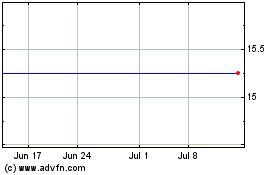Calpine Warns of Negative Consequences If Environmental Restrictions on Emergency Diesel Generators Are Eased for “Demand R...
February 03 2012 - 1:40PM
Business Wire
Calpine Corporation (NYSE:CPN) today filed comments with the
U.S. Environmental Protection Agency (EPA) objecting to a proposed
settlement agreement between the EPA and a group of Demand Response
(DR) providers that would allow emergency backup diesel generators
to quadruple their allowed operating hours without having to
install appropriate air emissions controls. The proposed settlement
would resolve a pending federal judicial appeal of EPA regulations
regarding the National Environmental Standards for Hazardous Air
Pollutants (NESHAP) for Reciprocating Internal Combustion Engines
(RICE).
“People tend to think of DR as a clean alternative to
fossil-fueled generation when, in fact, a significant amount of DR
is provided by emergency backup diesel-fueled generators that
operate without air emissions controls. DR resources are typically
called on during the hottest days of the year when the air quality
is already at its worst. Instead of reducing their electricity
consumption, many DR suppliers simply fire up their old diesel
engines,” said Thad Hill, Chief Operating Officer and Executive
Vice President of Calpine.
Under the current NESHAP RICE standard, emergency backup
generators are permitted to operate up to 15 hours per year without
any restriction on air emissions. The settlement would quadruple
allowable operating hours to 60, ostensibly for emergencies but in
reality for the economic gain of those generator owners and at a
cost to clean air.
DR is an initiative designed to reduce electric consumption from
the grid during periods of peak power demand. In the PJM market, DR
providers are paid to reduce consumption during such periods at the
same capacity price that power plants are paid to provide power.
Some DR is met by actual reduced consumption, but it appears that
about a third of the DR in PJM and adjacent markets is instead
based on starting up off-the-grid emergency backup generators to
supplant electric supply from the grid. In short, buildings and
businesses are getting paid to turn on their emergency backup
generators for economic gain rather than to respond to emergency
conditions. In PJM, 14,000 MW of DR is expected to be operational
by 2014. A significant portion of this is based on the aggregation
of emergency generators spewing dirty exhaust for economic gain
rather than true emergency response.
“As a company that has historically supported progressive clean
air standards, we do not see any compelling justification for a
waiver of air emissions requirements for emergency backup
generators that are not actually providing local emergency service
but are instead selling a capacity product into the regional
wholesale electricity market,” Hill said.
Calpine’s comments point out that in addition to the direct
adverse impact on air quality, allowing these dirtier units to
participate in the market as capacity resources displaces
investment in far cleaner and more reliable generation.
“Encouraging the operation of dirty generating resources is not
sound environmental or energy policy,” Hill added. “The irony is
that we may end up seeing the replacement of a meaningful portion
of retired coal-fired capacity with diesel generation with no air
emissions controls due to the manner in which policymakers are
allowing DR to be implemented. The EPA should not allow the growth
in ‘DR’ to become a ‘Diesel Renaissance.’ ”
About Calpine
Founded in 1984, Calpine Corporation is a major U.S. power
company, currently capable of delivering approximately 28,000
megawatts of clean, cost-effective, reliable and fuel-efficient
power from its 92 operating plants to customers and communities in
20 U.S. states and Canada. Calpine Corporation is committed to
helping meet the needs of an economy that demands more and cleaner
sources of electricity. Calpine owns, leases and operates primarily
low-carbon, natural gas-fired and renewable geothermal power
plants. Using advanced technologies, Calpine generates power in a
reliable and environmentally responsible manner for the customers
and communities it serves. Please visit our website at
www.calpine.com for more information.
Forward-Looking Information
In addition to historical information, this release contains
forward-looking statements within the meaning of Section 27A of the
Securities Act of 1933, as amended, and Section 21E of the
Securities Exchange Act of 1934, as amended. Words such as
“believe,” “intend,” “expect,” “anticipate,” “plan,” “may,” “will”
and similar expressions identify forward-looking statements. Such
statements include, among others, those concerning expected
financial performance and strategic and operational plans, as well
as assumptions, expectations, predictions, intentions or beliefs
about future events. You are cautioned that any such
forward-looking statements are not guarantees of future performance
and that a number of risks and uncertainties could cause actual
results to differ materially from those anticipated in the
forward-looking statements. Please see the risks identified in this
release or in Calpine’s reports and registration statements filed
with the Securities and Exchange Commission, including, without
limitation, the risk factors identified in its Annual Report on
Form 10-K for the year ended Dec. 31, 2010. These filings are
available by visiting the Securities and Exchange Commission’s
website at www.sec.gov or Calpine’s website at www.calpine.com.
Actual results or developments may differ materially from the
expectations expressed or implied in the forward-looking
statements, and Calpine undertakes no obligation to update any such
statements.
Calpine (NYSE:CPN)
Historical Stock Chart
From May 2024 to Jun 2024

Calpine (NYSE:CPN)
Historical Stock Chart
From Jun 2023 to Jun 2024
